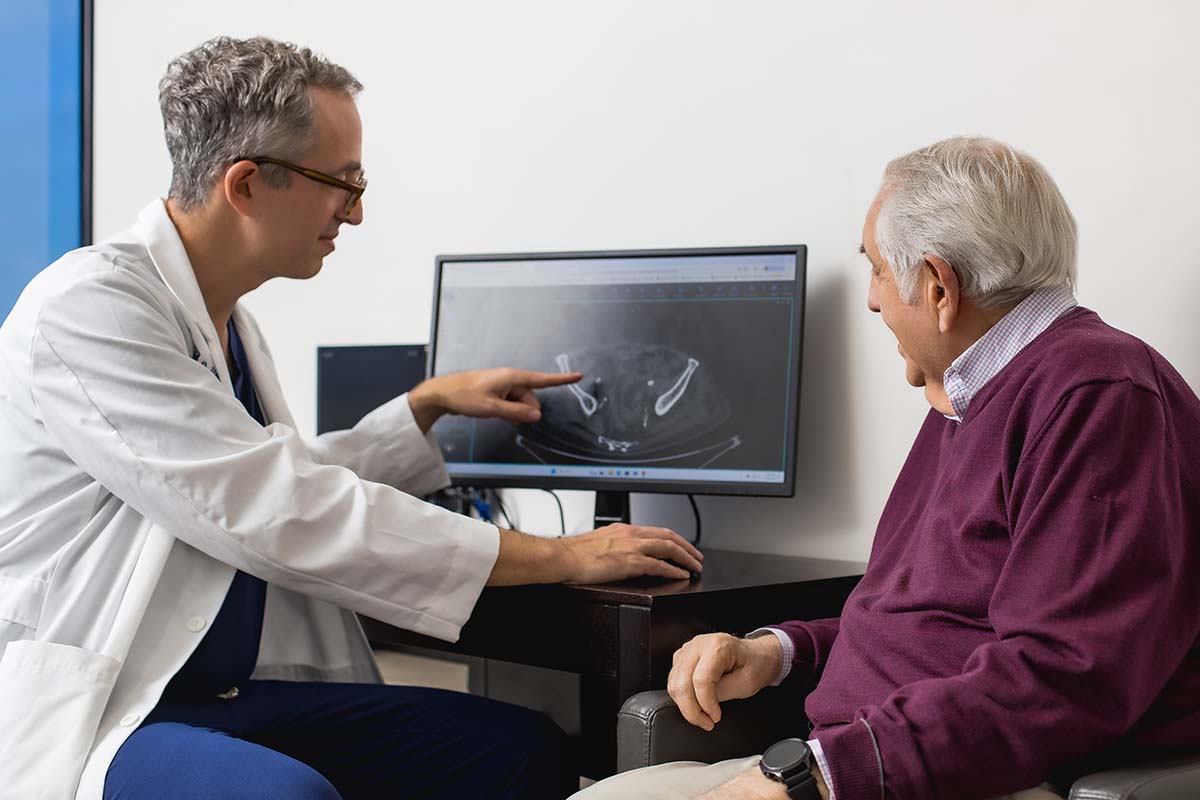If you’re struggling with an enlarged prostate and its frustrating symptoms, prostate artery embolization (PAE) offers relief without surgery. This minimally invasive procedure, performed by Dr. Jonathan Steinberger and Dr. Gabriel Lipshutz at DOCS Interventional Medicine, shrinks the prostate by reducing its blood supply—helping you regain comfort and control.
Shrink an enlarged prostate and relieve symptoms
Prostate embolization in Los Angeles is a minimally invasive procedure that treats benign prostatic hyperplasia (BPH) or an enlarged prostate. Performed by Dr. Lipshutz and Dr. Steinberger, PAE works by blocking blood flow to the prostate, causing it to shrink and relieve urinary symptoms. Our interventional radiologists use advanced imaging to guide tiny particles into the arteries supplying the prostate to reduce its size while preserving function. Unlike surgery, PAE requires no incisions, no hospital stay, and minimal downtime.
PAE: WHAT TO KNOW

What does prostate artery embolization (PAE) treat?
PAE is an effective treatment for benign prostatic hyperplasia (BPH), or an enlarged prostate, a condition that affects many men as they age. When the prostate grows, it can press against the urethra, leading to frustrating urinary symptoms. By reducing blood flow to the prostate, PAE helps shrink the gland, relieving symptoms and improving quality of life without surgery.
If you’re experiencing any of the following, PAE may be the solution for you:
- Frequent urges to urinate, especially at night
- Weak or slow urine stream
- Difficulty starting urination
- Feeling like the bladder doesn’t fully empty
- Sudden, urgent need to urinate
- Stopping and starting during urination
- Straining or discomfort while urinating
How does prostate artery embolization (PAE) work?
Prostate embolization in Los Angeles is a minimally invasive procedure that reduces the size of an enlarged prostate by blocking its blood supply. Using advanced imaging, Dr. Lipshutz and Dr. Steinberger insert a tiny catheter into an artery—usually in the wrist or groin—and guide it to the arteries feeding the prostate. Microscopic beads are then released, which help reduce blood flow and cause the prostate to shrink naturally over time. With less pressure on the urethra, urinary symptoms improve, restoring normal function without surgery or long recovery times.
Advantages of prostate artery embolization (PAE):
- Minimally invasive, with no incisions or stitches
- Outpatient procedure, allowing you to go home the same day
- Faster recovery compared to traditional surgery
- Lower risk of complications, including sexual or urinary side effects
- No need for a catheter in most cases
- Effective symptom relief, improving urinary function and quality of life
- Preserves prostate function, avoiding the need for removal
- Performed under local anesthesia, reducing risks associated with general anesthesia
- Suitable for high-risk patients who may not qualify for surgery

What is recovery like after PAE?
Recovery after prostate artery embolization (PAE) is typically quick and involves minimal downtime. Since PAE is minimally invasive, you can usually go home the same day and resume most daily activities within a few days. You may experience mild discomfort, frequent urination, or slight fatigue for a short period, but these symptoms gradually improve. Unlike traditional surgery, there are no incisions, no hospital stays, and no long recovery period. Within weeks, you’ll notice significant relief as your prostate shrinks.
Prostate artery embolization (PAE) FAQs
How long does it take to see results after PAE?
Most patients begin noticing symptom improvement within a few weeks, but full results typically develop over two to three months as the prostate gradually shrinks. The speed of improvement varies from person to person, but many men experience significant relief over time.
Is PAE painful?
Los Angeles prostate embolization is a minimally invasive, well-tolerated procedure performed under local anesthesia with light sedation. Most patients report little to no pain during the procedure. Afterward, some may experience mild pelvic discomfort, frequent urination, or burning sensations for a few days, but these symptoms are temporary and manageable with over-the-counter pain relievers.
How long does the PAE procedure take?
The procedure usually takes 90 minutes to two hours, depending on the complexity of your case. Since PAE is an outpatient procedure, you’ll go home the same day.
Are there any risks or side effects of PAE?
PAE has a low risk of complications, especially compared to surgical treatments for BPH. Some men experience temporary urinary symptoms, mild pain, or fatigue after the procedure. Serious side effects, such as infection or unintended embolization of nearby tissues, are rare when performed by experienced specialists like Dr. Steinberger and Dr. Lipshutz.
Am I a good candidate for PAE?
PAE is ideal for men with moderate to severe BPH symptoms, especially those who want to avoid surgery or are not candidates for surgical treatments. A consultation with Dr. Lipshutz and Dr. Steinberger will help determine if PAE is the best option for you.

Schedule your consultation in Los Angeles
DOCS Interventional Medicine is a leader in advanced, minimally invasive treatments that improve your health and quality of life. Led by Dr. Steinberger and Dr. Lipshutz, our practice provides expert care in a compassionate, sophisticated environment. With over a decade of experience at Cedars-Sinai, our interventional radiologists deliver cutting-edge treatments with the highest level of skills. If you’re struggling with BPH, schedule a consultation today to learn how prostate embolization in Beverly Hills & Los Angeles can help you regain control.